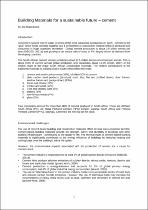JavaScript is disabled for your browser. Some features of this site may not work without it.
- ResearchSpace
- →
- Research Publications/Outputs
- →
- Book Chapters
- →
- View Item
| dc.contributor.author |
Mapiravana, Joseph

|
|
| dc.date.accessioned | 2014-08-08T09:27:39Z | |
| dc.date.available | 2014-08-08T09:27:39Z | |
| dc.date.issued | 2014-03 | |
| dc.identifier.citation | Mapiravana, J. 2014. Building materials for a sustainable future – cement. In: Green Building Handbook, South Africa: Volume 6: The Essential Guide, pp 87-97 | en_US |
| dc.identifier.issn | 9780620452403 | |
| dc.identifier.uri | http://www.alive2green.com/greenbuilding/handbook/volume6/files/assets/basic-html/page89.html | |
| dc.identifier.uri | http://hdl.handle.net/10204/7578 | |
| dc.description | Copyright; 2014 Alive2green, Cape Town, South Africa | en_US |
| dc.description.abstract | Concrete is second only to water in terms of the most consumed substances on earth. Cement is the "glue" which holds concrete together and it is therefore a construction material which is produced and consumed in huge quantities worldwide. Global cement production is about 2.8 billion tonnes per year (WBCSD, 2011a) and growing at an annual rate of close to 4%, largely driven by demand from developing countries. The South African cement industry produces about 17.5 million tonnes of cement per annum. This is about 0.6% of current annual global production and constitutes about 16.5% (CIDB, 2007) of the market share of the major South African construction materials. The relative contributions of the traditional materials to building cost in South Africa follow the order: 1. cement and reinforced concrete (35%), of which 50% is cement, 2. plain carbon steel products (structural steel, tiles, flat and profiled sheets, door frames, window frames and garage doors) (23%), 3. bricks and blocks (12%), 4. Timber and wood (10%), 5. Tiles and sanitary ware (9%), 6. plastics (4%), 7.non-ferrous metals (4%), 8. glass (3%). Four companies account for more than 80% of cement produced in South Africa. These are AfriSam South Africa (Pty) Ltd, Natal Portland Cement (NPC) Cimpor, Lafarge South Africa and Pretoria Portland Cement (PPC). Sephaku Cement is the new kid on the block. | en_US |
| dc.language.iso | en | en_US |
| dc.publisher | Alive2green | en_US |
| dc.relation.ispartofseries | Workflow;13200 | |
| dc.subject | Concrete | en_US |
| dc.subject | Construction materials | en_US |
| dc.subject | Building materials | en_US |
| dc.subject | Carbon steel products | en_US |
| dc.subject | Timber materials | en_US |
| dc.subject | Tiles | en_US |
| dc.subject | Sanitary ware | en_US |
| dc.subject | Plastics | en_US |
| dc.subject | Non-ferrous metals | en_US |
| dc.subject | Glass | en_US |
| dc.subject | Cement production | en_US |
| dc.title | Building materials for a sustainable future – cement | en_US |
| dc.type | Book Chapter | en_US |
| dc.identifier.apacitation | Mapiravana, J. (2014). Building materials for a sustainable future – cement., <i>Workflow;13200</i> Alive2green. http://hdl.handle.net/10204/7578 | en_ZA |
| dc.identifier.chicagocitation | Mapiravana, Joseph. "Building materials for a sustainable future – cement" In <i>WORKFLOW;13200</i>, n.p.: Alive2green. 2014. http://hdl.handle.net/10204/7578. | en_ZA |
| dc.identifier.vancouvercitation | Mapiravana J. Building materials for a sustainable future – cement.. Workflow;13200. [place unknown]: Alive2green; 2014. [cited yyyy month dd]. http://hdl.handle.net/10204/7578. | en_ZA |
| dc.identifier.ris | TY - Book Chapter AU - Mapiravana, Joseph AB - Concrete is second only to water in terms of the most consumed substances on earth. Cement is the "glue" which holds concrete together and it is therefore a construction material which is produced and consumed in huge quantities worldwide. Global cement production is about 2.8 billion tonnes per year (WBCSD, 2011a) and growing at an annual rate of close to 4%, largely driven by demand from developing countries. The South African cement industry produces about 17.5 million tonnes of cement per annum. This is about 0.6% of current annual global production and constitutes about 16.5% (CIDB, 2007) of the market share of the major South African construction materials. The relative contributions of the traditional materials to building cost in South Africa follow the order: 1. cement and reinforced concrete (35%), of which 50% is cement, 2. plain carbon steel products (structural steel, tiles, flat and profiled sheets, door frames, window frames and garage doors) (23%), 3. bricks and blocks (12%), 4. Timber and wood (10%), 5. Tiles and sanitary ware (9%), 6. plastics (4%), 7.non-ferrous metals (4%), 8. glass (3%). Four companies account for more than 80% of cement produced in South Africa. These are AfriSam South Africa (Pty) Ltd, Natal Portland Cement (NPC) Cimpor, Lafarge South Africa and Pretoria Portland Cement (PPC). Sephaku Cement is the new kid on the block. DA - 2014-03 DB - ResearchSpace DP - CSIR KW - Concrete KW - Construction materials KW - Building materials KW - Carbon steel products KW - Timber materials KW - Tiles KW - Sanitary ware KW - Plastics KW - Non-ferrous metals KW - Glass KW - Cement production LK - https://researchspace.csir.co.za PY - 2014 SM - 9780620452403 T1 - Building materials for a sustainable future – cement TI - Building materials for a sustainable future – cement UR - http://hdl.handle.net/10204/7578 ER - | en_ZA |






